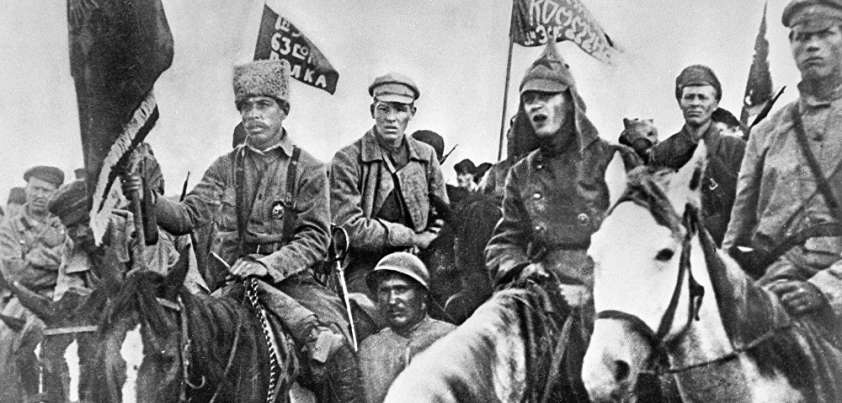 Today we have three stories (Crossing the Zbrucz, My First Goose and Salt) from Red Cavalry, a collection of edited entries from the war diary of Russian author Isaac Babel. The stories reflect his time as a journalist / propagandist attached to the First Cavalry unit of the Red Army during the Polish-Soviet War of 1920. These are not typical war stories involving great battles and inspiring heroes. Instead, the book provides a graphic insight into the human impact of the war on those fighting it, as well as the casualties and brutalities inflicted by both sides on innocent civilians. More…
Today we have three stories (Crossing the Zbrucz, My First Goose and Salt) from Red Cavalry, a collection of edited entries from the war diary of Russian author Isaac Babel. The stories reflect his time as a journalist / propagandist attached to the First Cavalry unit of the Red Army during the Polish-Soviet War of 1920. These are not typical war stories involving great battles and inspiring heroes. Instead, the book provides a graphic insight into the human impact of the war on those fighting it, as well as the casualties and brutalities inflicted by both sides on innocent civilians. More…
Day of the Butterfly
 The themes of this distressing story from Alice Munro are being different, isolation, bullying, connection and betrayal. Myra’s family looks and dresses differently. At school, her introverted younger brother needs her constant support and protection. The other children in her class (always in groups of course!) ridicule her. For most of them, feigned acceptance comes when Myra is hospitalized with leukemia and it becomes fashionable to be seen to care. Sadly, a brief period of connection with the narrator ends with a decision to discard what may have been Myra’s last ever gift More…
The themes of this distressing story from Alice Munro are being different, isolation, bullying, connection and betrayal. Myra’s family looks and dresses differently. At school, her introverted younger brother needs her constant support and protection. The other children in her class (always in groups of course!) ridicule her. For most of them, feigned acceptance comes when Myra is hospitalized with leukemia and it becomes fashionable to be seen to care. Sadly, a brief period of connection with the narrator ends with a decision to discard what may have been Myra’s last ever gift More…
Camp Cataract
 This story from Jane Bowles examines the toxic relationship between three troubled sisters who share a city apartment. One of them is midway through a ten-week holiday in a Camp Cataract cabin as part of a long-term plan to move out and live independently. When another turns up uninvited, hoping to convince her to cut the holiday short, they arrange to meet for lunch the next day. Both have different recollections of what happens the following morning. Madness intervenes, and only one of them survives the day. Themes: self-analysis, identity, independence, mental illness, spinsterhood, female relationships. More…
This story from Jane Bowles examines the toxic relationship between three troubled sisters who share a city apartment. One of them is midway through a ten-week holiday in a Camp Cataract cabin as part of a long-term plan to move out and live independently. When another turns up uninvited, hoping to convince her to cut the holiday short, they arrange to meet for lunch the next day. Both have different recollections of what happens the following morning. Madness intervenes, and only one of them survives the day. Themes: self-analysis, identity, independence, mental illness, spinsterhood, female relationships. More…
The Water-Faucet Vision
 In this humorous story by Gish Jen, a Chinese-American woman whose mother recently passed away reflects on a brief period in her childhood when her mother somehow fell out of their bedroom window. At the time of the fall she was a fifth grader in a Catholic school, obsessed with the idea of becoming a martyr and performing miracles. When her precious comfort beads fall through a drainage grate in the road, she wakes to a “vision” telling her how to recover them. Themes include religious belief, marital conflict, family, friendship, loss. More…
In this humorous story by Gish Jen, a Chinese-American woman whose mother recently passed away reflects on a brief period in her childhood when her mother somehow fell out of their bedroom window. At the time of the fall she was a fifth grader in a Catholic school, obsessed with the idea of becoming a martyr and performing miracles. When her precious comfort beads fall through a drainage grate in the road, she wakes to a “vision” telling her how to recover them. Themes include religious belief, marital conflict, family, friendship, loss. More…
Cell One
 Some websites describe Nnamabia, the young protagonist in this story by Chimamanda Ngozi Adichie, using terms such as ‘a wayward, rebellious son’. This is treating him too kindly. At the beginning of the story, Nnamabia is an entitled, spoiled, manipulative brat… too weak-willed to resist imitating the petty thefts of his peers, yet so cowardly that the only person he is game enough to steal from is his mother. Although he did not deserve the punishment he received at the hands of the so-called Nigerian justice system, he learnt some important lessons and came out of it a man. More…
Some websites describe Nnamabia, the young protagonist in this story by Chimamanda Ngozi Adichie, using terms such as ‘a wayward, rebellious son’. This is treating him too kindly. At the beginning of the story, Nnamabia is an entitled, spoiled, manipulative brat… too weak-willed to resist imitating the petty thefts of his peers, yet so cowardly that the only person he is game enough to steal from is his mother. Although he did not deserve the punishment he received at the hands of the so-called Nigerian justice system, he learnt some important lessons and came out of it a man. More…